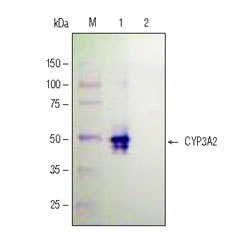Simple, Efficient Extraction of Protein From Hepatocytes with CytoBuster™ Reagent
Cytochromes p450 (CYP) are a large group of heme-containing mono-oxygenases which catalyse many important biological functions (1). These most notably include the oxidative conversions of many steroids, lipids, environmental toxins and xenobiotics. This family of enzymes plays a significant role in the biotransformation of drugs, they have a broad substrate specificity, and expression is induced in response to a variety of commonly used compounds (2–5). In the search for new pharmaceuticals, many factors determine the success of lead compounds. The effect of these compounds on CYP protein expression levels is valuable information for predicting possible drug interactions and may help determine their potential as marketable drugs.
CYP protein analysis
Western analysis of CYPs in isolated hepatocytes is a useful tool for detecting changes in CYP levels. Cells must be lysed to release these and many other proteins contained within. There are several protocols for protein preparation, which include detergent disruption (sodium dodecyl sulphate; SDS), mechanical disruption (Dounce homogeniser) and phenol extraction.
Samples prepared in SDS based buffers result in complete cell lysis, but high viscosity (due to the release of chromosomal DNA) is often a problem when loading samples on the gel. Vigorous mechanical disruption such as sonication or passing the samples through a hypodermic needle are often used to overcome the “stickiness” often encountered. Some degradation of the protein in both of these methods has been observed, resulting in smearing of the band on the immunoblot. Although effective, mechanical disruption generally results in larger volumes of diluted sample, which is inconvenient when sample volumes may not exceed 20–50 μL. Phenol extraction may result in high protein yields but can be time consuming and the reagents themselves are unpleasant to use.
CytoBuster™ Protein Extraction Reagent is a proprietary formulation of detergents prepared for the efficient extraction of soluble proteins from mammalian cells. CytoBuster enables the isolation of functionally active proteins without the need for secondary treatment such as sonication. It provides a simple, quick, low cost alternative to the previously discussed methods.
Extract preparation and Western Analysis
Rat hepatocytes (250,000 cells) were pelleted and washed in 1X PBS. CytoBuster™ Reagent (50 μL) was added and the cells resuspended. The samples were incubated on ice for 15 minutes, and the insoluble cell debris was pelleted at 16,000 ·g for 2 minutes. The soluble supernatant fraction was transferred to a fresh tube and the insoluble pellets discarded.
Extractions reproducibly yielded between 15 and 25 mg/mL of protein, as measured using the Bio-Rad DC Protein Assay. Editor’s note: CytoBuster Reagent is compatible with many standard protein assay methods.
Fig. 1 shows a Western blot of a hepatocyte extract prepared using CytoBuster Reagent. CYP3A2 was detected using a polyclonal antibody with an alkaline phosphatase conjugated secondary antibody. Novagen’s Trail Mix™ Western Markers were run in an adjacent lane, and visualized along with CYP3A2 by including S-protein AP Conjugate in the secondary antibody incubation. The blot shows a strong antibody-reactive band at the expected size for CYP3A2, which indicates that the target protein was efficiently extracted with CytoBuster Reagent. We are currently using CytoBuster routinely to prepare extracts from a variety of cell lines.

Figure 1.Western blot analysis showing CYP3A2 protein in rat hepatocytes Rat hepatocytes (250K cells) were lysed using CytoBuster Protein Extraction Reagent as described in the text. A 5 μg protein sample was mixed directly with an equal volume of SDS sample buffer (250 mM Tris-HCl pH 6.8, 10% glycerol, 0.01% bromophenol blue, 100 mM DTT) and loaded onto a 9% SDS-PAGE gel. Proteins were transferred to PVDF membrane and the Western blot was probed with goat anti-CYP3A2 polyclonal antibody followed by an AP conjugated secondary antibody. Trail Mix Western Markers were detected in an adjacent lane by including S-protein AP conjugate (Novagen) in the secondary antibody incubation. Chromogenic detection was performed with NBT/BCIP substrates (Novagen). M, markers; 1, hepatocyte sample; 2, CytoBuster only.
Summary
CytoBuster Protein Extraction Reagent is a user friendly system for the reproducible analysis of CYP proteins. It is now possible to efficiently and rapidly extract soluble proteins from mammalian cells for CYP analysis without exposing them to the harsh conditions often associated with secondary treatments such as sonication.
Advantages demonstrated independently and by these experiments include:
- Speed and decreased handling result in less protein degradation.
- Significant viscosity reduction relative to other methods makes samples easy to load onto the SDS-PAGE gel, decreasing the variability often observed in this technique.
Proteins are efficiently extracted at a reproducible, high concentration. In addition, the extract is compatible with the laboratory preferred protein assay. CytoBuster Protein Extraction Reagent represents a significantly improved method for protein extraction.
Materials
To continue reading please sign in or create an account.
Don't Have An Account?